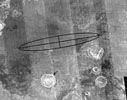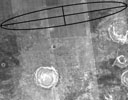Flung Far from Home
Caption:

|

|
|
Figure 1
|
Figure 2
|
|

Figure 3
The rock dubbed "Bounce" at Meridiani Planum, Mars, may have been thrown onto the plains during an impact that formed a 25-kilometer-diameter (15.5-mile) crater (arrow) located 50 kilometers (31 miles) southeast of the Mars Exploration Rover Opportunity's landing site (to the right of ellipse center). This infrared Mars Odyssey image taken by the thermal emission imaging system shows the pattern of ejecta, or material, thrown from the large crater. Rays of this rocky material can be seen radiating outward from the crater. The Opportunity landing site is close to one of these rays, as well as other rays of small impact craters seen in high-resolution Mars Odyssey camera images within 5 kilometers (3.1 miles) of the landing site. Bounce rock may be a smaller piece of material ejected onto the plains by this impact event.
Figures 1, 2, and 3 above, infrared images increasing in zoom, taken by the thermal emission imaging system on the Mars Odyssey orbiter at night, show the pattern of ejecta, or material, thrown from the large crater. Large rocks on the surface stay warm at night and produce a bright signature. Rays of this rocky material can be seen radiating outward from the crater.
Cataloging Keywords:
| Name |
Value |
Additional Values |
| Target |
Mars |
|
| System |
|
|
| Target Type |
Planet |
|
| Mission |
Mars Exploration Rover (MER) |
2001 Mars Odyssey |
| Instrument Host |
Mars Odyssey |
Opportunity (MER-B) |
| Host Type |
Orbiter |
Rover |
| Instrument |
Thermal Emission Imaging System (THEMIS) |
|
| Detector |
|
|
| Extra Keywords |
Crater, Grayscale, Impact, Infrared, Thermal |
| Acquisition Date |
|
| Release Date |
2004-04-15 |
| Date in Caption |
|
|
| Image Credit |
NASA/JPL/ASU |
| Source |
photojournal.jpl.nasa.gov/catalog/PIA05760 |
| Identifier |
PIA05760 |




